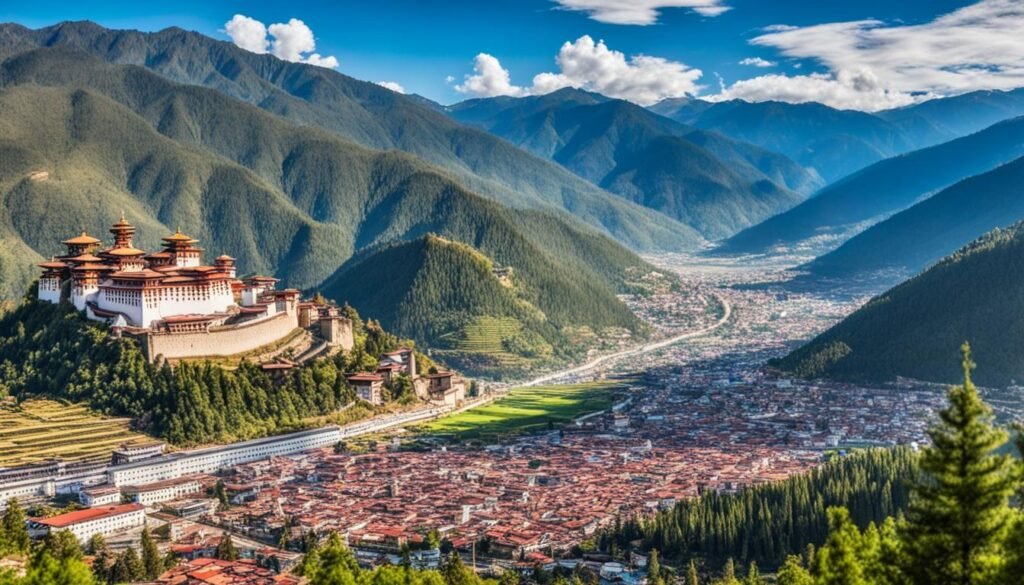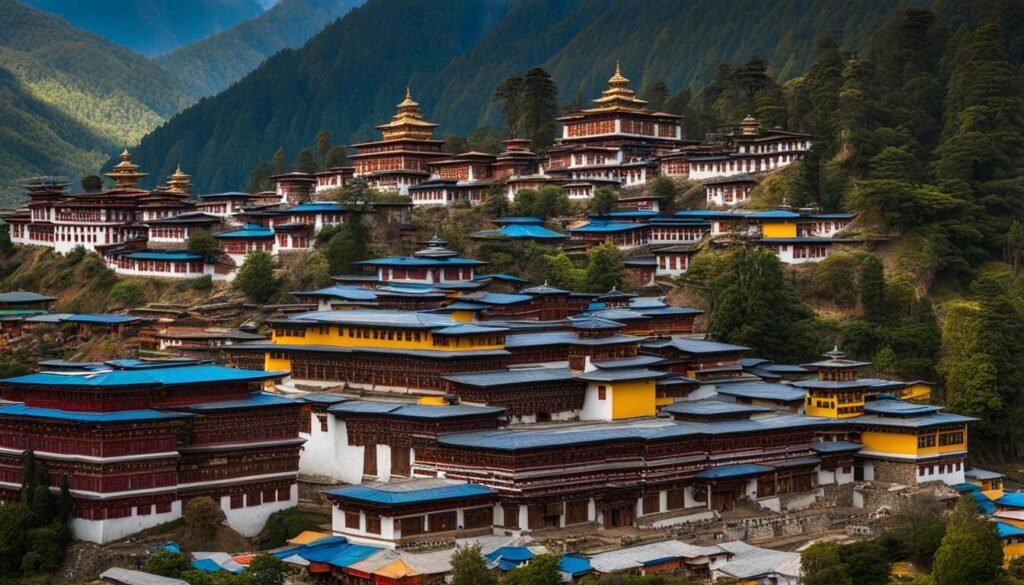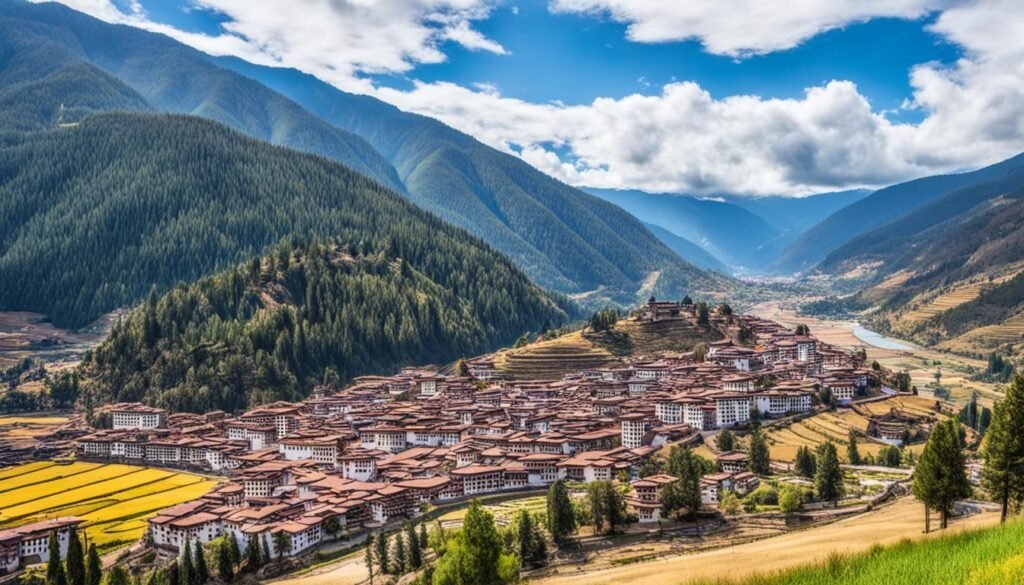Bhutan, known as the Land of the Thunder Dragon, is a mystical kingdom with a rich cultural heritage and breathtaking natural beauty. With its recent reopening to international travelers, now is the perfect time to embark on a journey to this enchanting destination. But with so many cities to explore, which ones should be at the top of your list?
Join us as we unveil the top 10 cities to visit in Bhutan. From ancient temples to stunning landscapes, these cities offer a unique blend of spirituality, tradition, and adventure. Uncover the hidden gems that make Bhutan a must-visit destination for every traveler.
Key Takeaways:
- Explore the top 10 cities in Bhutan, each offering a unique experience.
- Discover ancient temples, monasteries, and dzongs that showcase Bhutan’s rich cultural heritage.
- Immerse yourself in the stunning landscapes and breathtaking natural beauty of the Land of the Thunder Dragon.
- Uncover the hidden gems and off-the-beaten-path destinations that few tourists know about.
- Get valuable travel tips and insights to make the most of your Bhutanese adventure.
Paro – Beautiful valley, home to some of the oldest Bhutan temples and monasteries, major airhub
Discover the enchanting beauty of Paro, a picturesque city nestled in its own beautiful valley in Bhutan. Paro is not only known for its breathtaking landscapes and serene ambiance but also for being the home to some of the oldest Bhutanese temples and monasteries.
One of the most iconic sites in Paro is the Taktsang Monastery, also known as the Tiger’s Nest Monastery. Perched on a cliff face, this ancient monastery offers awe-inspiring views of the Paro Valley. Legend has it that Guru Rinpoche, the founder of Tibetan Buddhism, flew to this spot on the back of a tigress, giving the monastery its name.
In Paro, you can also visit the Rinpung Dzong, a historic monastic fortress that has watched over the valley for centuries. This architectural masterpiece houses various temples, administrative offices, and monk quarters, providing a glimpse into Bhutan’s rich cultural heritage.
Not only steeped in history and spirituality, Paro is also the major airhub in Bhutan, serving as the main entry point for international tourists. Its well-connected airport allows visitors to easily access the city and explore the wonders of Bhutan.
“Paro is a sanctuary of ancient temples, monasteries, and natural beauty, beckoning travelers to immerse themselves in Bhutan’s rich cultural tapestry.”
Whether you seek spiritual enlightenment, natural wonders, or simply a tranquil escape, Paro offers it all. Explore the oldest temples and monasteries, marvel at the surreal beauty of the Paro Valley, and embark on a journey of self-discovery in this captivating city.
Thimphu – Capital of Bhutan, center of government, religion, and commerce
Thimphu, the capital city of Bhutan, holds a significant position as the center of government, religion, and commerce in the kingdom. Situated in the central western part of Bhutan, Thimphu offers a captivating fusion of traditional Buddhist culture and modern conveniences. With a population that exceeds that of any other city in Bhutan, Thimphu is a vibrant hub that showcases the country’s unique heritage and progress.
Thimphu is adorned with cultural attractions that delight both locals and tourists. One prominent landmark is the awe-inspiring Buddha Dordenma statue, which stands tall at 169 feet and offers a mesmerizing sight. This majestic sculpture represents the Buddha’s compassion and acts as a symbol of peace and happiness for Bhutan and its people.
Another notable site is the Memorial Chorten, a revered monument dedicated to the late King Jigme Dorji Wangchuck. This fascinating structure attracts devotees who engage in prayer and circumambulation, creating a serene atmosphere of reverence and remembrance.
The Tashichho Dzong, an imposing fortress and monastery, stands proudly in Thimphu and serves as the seat of the Bhutanese government. It houses the throne room of the King of Bhutan, making it a vital center for political affairs. The Tashichho Dzong’s grandeur is enhanced by its stunning traditional architecture, intricate woodwork, and vibrant Buddhist paintings.
Thimphu not only boasts its religious and governmental significance but also thrives as a commercial center for Bhutan. The city’s bustling markets and shopping districts offer a delightful blend of traditional handicrafts, contemporary artwork, and colorful textiles. Visitors can explore the bustling stalls and shops to discover unique souvenirs that reflect Bhutanese craftsmanship.
Amidst the urban landscape, Thimphu also provides access to the breathtaking Thimphu Valley, which beckons outdoor enthusiasts with its scenic beauty and serene surroundings. The valley offers numerous opportunities for trekking and hiking adventures, allowing visitors to immerse themselves in Bhutan’s pristine natural landscapes.
Cultural Attractions in Thimphu
- Buddha Dordenma statue
- Memorial Chorten
- Tashichho Dzong
Experience the Thimphu Valley
- Trekking
- Hiking
“Thimphu, the capital city of Bhutan, serves as the vibrant heart of governmental affairs, religious devotion, and bustling commerce. Its cultural attractions and proximity to the stunning Thimphu Valley make it an unmissable destination for travelers seeking to delve into the rich tapestry of Bhutan’s heritage and landscapes.” – Local Bhutanese Official
| Cultural Attractions | Natural Beauty | Commerce |
|---|---|---|
| Buddha Dordenma statue | Thimphu Valley | Shopping districts |
| Memorial Chorten | Trekking | Local markets |
| Tashichho Dzong | Hiking | Handicrafts |

Immerse yourself in the vibrant energy and deep-rooted traditions of Thimphu, the capital of Bhutan. From significant religious sites to awe-inspiring natural beauty, this city is a gateway to a world where ancient culture and modern progress harmoniously coexist.
Punakha – Former capital of Bhutan
Punakha, located in a picturesque valley at the confluence of the Mo Chhu and Pho Chhu rivers, holds the distinction of being the former capital of Bhutan. This historic city is known for its cultural significance, stunning landscapes, and its iconic Punakha Dzong.
The Punakha Dzong, also known as the Palace of Great Bliss, is one of the most magnificent fortresses in Bhutan. Its grandeur and intricate architecture make it a must-visit attraction for tourists. The dzong, with its towering whitewashed walls and golden roofs, serves as the winter residence of the head abbot of Bhutan’s monastic order.
Punakha is also famous for its rice-growing areas, where the unique and flavorful red rice of Bhutan is cultivated. The fertile valleys surrounding Punakha provide ideal conditions for rice cultivation, and the local farmers take great pride in their harvest.
With its rich history, stunning natural beauty, and cultural significance, Punakha continues to captivate visitors with its charm and allure.
“Punakha is a treasure trove of Bhutanese heritage, offering a glimpse into the country’s glorious past and captivating natural beauty.” – Travel enthusiast
Notable Attractions in Punakha
- Punakha Dzong – A majestic fortress overlooking the confluence of the Mo Chhu and Pho Chhu rivers.
- Chimi Lhakhang – A sacred temple dedicated to the Divine Madman and renowned for its phallic symbols.
- Sangchhen Dorji Lhuendrup Nunnery – A beautiful nunnery providing panoramic views of the Punakha valley.
- Khamsum Yulley Namgyal Chorten – A stunning chorten offering panoramic views of the Punakha valley.
| Climate | Temperature (°C) | Precipitation (mm) |
|---|---|---|
| Spring (March – May) | 14°C – 23°C | 20mm – 60mm |
| Summer (June – August) | 15°C – 25°C | 300mm – 600mm |
| Autumn (September – November) | 12°C – 22°C | 50mm – 200mm |
| Winter (December – February) | 5°C – 16°C | 20mm – 40mm |
Trongsa – Central hub of Bhutan with spectacular landscape and dzongs
Trongsa is a central hub in Bhutan that offers a truly captivating experience with its spectacular landscape and historic dzongs. Nestled among the majestic mountains, Trongsa is a must-visit destination for travelers seeking awe-inspiring natural beauty and cultural heritage.
At the heart of Trongsa lies the magnificent Trongsa Dzong, perched on a steep ridge and commanding breathtaking views of the surrounding valleys. This impressive fortress holds great significance as the ancestral seat of the Wangchuck dynasty, who later became the royal family of Bhutan. The Trongsa Dzong stands as a testament to the rich history and architectural brilliance of the region.
Another notable attraction in Trongsa is the Trongsa Ta Dzong, a historic watchtower that has been beautifully restored and converted into a museum. This museum offers an enriching journey through the history of Bhutan, showcasing ancient artifacts, royal memorabilia, and intriguing exhibits that shed light on the cultural heritage of the country.
Trongsa’s strategic location further adds to its significance. Positioned at the crossroads between east and west Bhutan, the city historically controlled the vital trade routes of the region. Today, Trongsa continues to serve as a central hub, connecting various parts of the country and offering a glimpse into the authentic Bhutanese way of life.
Trongsa’s picturesque landscape, adorned with lush green valleys, cascading waterfalls, and pristine forests, welcomes nature enthusiasts with open arms. The region’s tranquility and untouched beauty make it an ideal destination for hiking, trekking, and exploring the great outdoors.
Whether you are fascinated by historical landmarks, captivated by stunning landscapes, or eager to immerse yourself in the unique culture of Bhutan, Trongsa has it all. This central hub of Bhutan offers a truly memorable experience that will leave a lasting impression on every traveler.
Jakar – Cultural and religious center of Bhutan
Jakar, also known as Chamkhar, is a cultural and religious center in Bhutan. It is located in the beautiful Choekhor Valley surrounded by stunning mountains and alpine hills. This serene city holds great significance in Bhutan’s cultural and religious landscape, attracting visitors from around the world.
The highlight of Jakar is the Jakar Dzong, one of the largest and most impressive dzongs in Bhutan. This ancient fortress-monastery stands proudly on a ridge overlooking the valley, offering panoramic views of the surrounding landscapes. Inside the dzong, visitors can explore its intricate architecture, sacred temples, and learn about Bhutanese history and culture.
In addition to the Jakar Dzong, Jakar is also home to the Wangdicholing Palace, a majestic 19th-century palace of historical importance. The palace served as the summer residence of Bhutan’s royal family, and it now houses a museum that showcases artifacts, paintings, and other exhibits that depict the country’s rich heritage.
Another prominent religious site in Jakar is the Jakar Lhakhang, a 14th-century temple that holds tremendous religious significance in Bhutan. This temple is dedicated to the Guru Rinpoche, who is considered the patron saint of Bhutan and credited with the introduction of Buddhism to the country. Visitors can immerse themselves in Buddhist rituals and experience the spiritual atmosphere of the Jakar Lhakhang.
Jakar’s tranquil setting and numerous cultural and religious landmarks make it a must-visit destination for travelers seeking authentic Bhutanese experiences. Whether exploring the impressive Jakar Dzong, delving into the history at Wangdicholing Palace, or seeking spiritual solace at Jakar Lhakhang, Jakar offers a unique blend of cultural immersion and natural beauty.

The Jakar Dzong: A Fortress of Cultural and Spiritual Significance
“The Jakar Dzong stands as a symbol of Bhutan’s rich heritage and architectural prowess. Its commanding presence and timeless beauty make it an awe-inspiring sight for visitors.” – Local guide
Exploring Jakar’s Spiritual Legacy: Jakar Lhakhang
The Jakar Lhakhang, also known as the Jakar Monastery, is a sacred site that resonates with spiritual energy. It is an important place of worship for both locals and pilgrims, who come to seek blessings and engage in religious practices.
Discovering Bhutan’s Royal Legacy: Wangdicholing Palace
The Wangdicholing Palace offers visitors a glimpse into Bhutan’s royal history. The palace’s exquisite architecture and royal artifacts provide insights into the lives of Bhutan’s monarchy and their contribution to the country’s development.
Phobjikha – Home to black-necked cranes and Gangtey Monastery
Phobjikha is a breathtaking valley nestled in the heart of Bhutan and is renowned for its unique ecosystem, abundant wildlife, and cultural treasures. This serene valley serves as the winter home to the enchanting black-necked cranes, an endangered species that migrates to Phobjikha Valley every year. As these graceful birds return to their sanctuary, visitors can witness their awe-inspiring dances, making it a truly mesmerizing experience.
The valley is also home to the revered Gangtey Monastery, an architectural marvel that stands as a testament to Bhutan’s rich spiritual heritage. This monastery, also known as Gangtey Goenpa, holds great significance for the local community and serves as a place of worship and meditation.
Phobjikha Valley offers a paradise for nature enthusiasts, with its lush meadows, dense forests, and panoramic views of the majestic Himalayan Mountains. The valley is a sanctuary for a diverse range of flora and fauna, making it a must-visit destination for wildlife lovers and hikers alike. It is also part of the Jigme Singye Wangchuck National Park, protecting the natural treasures of this pristine region.
Experience the tranquility and natural beauty of Phobjikha, where you can witness the harmony between humans, wildlife, and nature. Immerse yourself in the serenity of the valley, explore the Gangtey Monastery, and capture unforgettable moments amidst the stunning landscapes.
Key Highlights of Phobjikha:
- Winter home of the endangered black-necked cranes
- Gangtey Monastery, a revered spiritual site
- Breathtaking landscapes and panoramic views
- Jigme Singye Wangchuck National Park’s diverse flora and fauna
Phobjikha Valley and Gangtey Monastery
| Location | Attractions |
|---|---|
| Phobjikha Valley |
|
| Gangtey Monastery |
|
Wangdue Phodrang – Tranquil town with a majestic dzong
Located in central Bhutan, Wangdue Phodrang is a serene and peaceful town known for its tranquil atmosphere and breathtaking natural surroundings. The town is home to the majestic Wangdue Phodrang dzong, a fortress-like structure that offers panoramic views of the surrounding valleys and mountains.
Wangdue Phodrang is nestled near Punakha and serves as a convenient border town for travelers exploring both regions. The town’s close proximity to Punakha makes it an ideal stop for those looking to experience the cultural and historical wonders of both places.
In addition to its natural and scenic beauty, Wangdue Phodrang is also known for its traditional crafts. The town is famous for producing bamboo products and intricate slate carvings, showcasing the skill and craftsmanship of the local artisans.
Whether you’re seeking a peaceful retreat or an opportunity to immerse yourself in Bhutan’s cultural heritage, Wangdue Phodrang is a must-visit destination. Experience the tranquility of this beautiful town and explore its majestic dzong for a truly unforgettable journey.
Phuentsholing – Border city close to India
Phuentsholing is a bustling border city in southern Bhutan, located near the Indian state of West Bengal. Positioned as the main overland entry point from India, this vibrant city is renowned for its bustling cross-border trade.
One of the city’s most iconic landmarks is the Bhutan Gate, an ornate border crossing that marks the entry into the kingdom of Bhutan. As you pass through the gate, you’ll be welcomed into the enchanting landscapes and rich culture of Bhutan.
While in Phuentsholing, don’t miss the opportunity to visit the ZangtoPelri Lhakhang, a temple that houses an exact likeness of Guru Rinpoche, the founder of Bhutanese Buddhism. Immerse yourself in the spiritual ambiance and explore the intricate details of this sacred site.
For a serene and reflective experience, visit the KarbandiGoemba, a winter residence of the Royal Grandmother. This peaceful refuge showcases impressive statues of Buddha and Padmasambhava, offering visitors a moment of tranquility and introspection.
FAQ
What are the top 10 cities to visit in Bhutan?
The top 10 cities to visit in Bhutan are Paro, Thimphu, Punakha, Trongsa, Jakar, Phobjikha, Wangdue Phodrang, Phuentsholing, Samdrup Jongkhar, and Trashigang.
Why is Paro a popular city for tourists?
Paro is a popular city for tourists because it is located in a beautiful valley, home to some of the oldest Bhutanese Buddhist temples and monasteries, and serves as a major airhub in Bhutan.
What are the cultural attractions in Thimphu?
Thimphu, the capital city of Bhutan, offers cultural attractions such as the Buddha Dordenma statue, Memorial Chorten, and Tashichho Dzong.
What is the significance of Punakha?
Punakha is the former capital of Bhutan and is known for its historic Punakha Dzong, which serves as the winter residence of the country’s national Buddhist order. Punakha is also famous for its rice-growing areas and the production of unique red rice.
What can visitors expect to see in Trongsa?
Visitors to Trongsa can expect to see stunning landscapes and historic dzongs. The Trongsa Dzong offers breathtaking views of the surrounding valleys, while the Trongsa Ta Dzong has been converted into a museum dedicated to the history of Bhutan.
What are the attractions in Jakar?
The attractions in Jakar, also known as Chamkhar, include the Jakar Dzong, one of the largest dzongs in Bhutan, the Wangdicholing Palace, and the Jakar Lhakhang, a 14th-century temple of great religious significance.
Why is Phobjikha a popular destination?
Phobjikha is a popular destination due to its breathtaking valley, unique ecosystem, and status as the winter home of endangered black-necked cranes. It is also home to the revered Gangtey Monastery and offers stunning views of the surrounding mountains and valleys.
What can visitors see in Wangdue Phodrang?
Visitors to Wangdue Phodrang can see the majestic Wangdue Phodrang dzong, which offers panoramic views of the surrounding valleys. The town is also known for its traditional crafts, such as bamboo products and slate carvings.
What is special about Phuentsholing?
Phuentsholing is a bustling border city located close to the Indian state of West Bengal. It is the main overland entry point from India and is known for vibrant cross-border trade. The city is home to the ornate Bhutan Gate, the ZangtoPelri Lhakhang temple, and the KarbandiGoemba, a winter residence of the Royal Grandmother.
